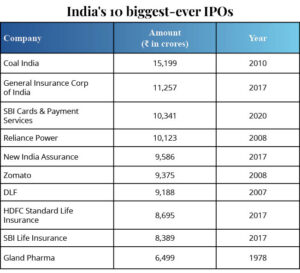The world of finance and investment is shaped by a pivotal event—the Initial Public Offering (IPO). It’s the moment when a company, often a promising startup or a well-established corporation, takes its first steps into the public realm, allowing investors to share its journey to success. From the historic voyage of the Dutch East India Company in 1602 to the present-day flurry of IPOs, the journey of Indian Initial Public Offerings highlights the nation’s growth. Let’s delve into the compelling history of IPOs in India to understand this concept better.
The history of Initial Public Offerings (IPOs) dates back to the year 1602 when the Dutch East India Company issued its first IPO. Indian capital market remained underdeveloped until the early 20th century. 1977 was a revolutionary year in the history of IPOs in India as Reliance Industries Limited made history by initiating its IPO. Priced at par value, the offering had an issue size amounting to Rs. 2.82 crore. The 1990s was the time when India welcomed foreign investment and liberalised its economy. This period saw the emergence of several big and iconic IPOs, including the listing of Narayana Murthy’s Infosys in 1993. It became the first company to list on a US stock exchange.
The early 2000s witnessed a boom in IPO activity in India, with many companies going public. Over the years, the Indian IPO Market has continued to evolve, shining a spotlight on India’s growing entrepreneurial spirit.
Needless to say, the Securities and Exchange Board of India (SEBI) plays a pivotal role here. The growing IPO market is how SEBI became the regulatory body of the Indian capital market. It is responsible for overseeing the entire IPO process and ensuring full transparency and fairness. To that end, SEBI has a set of guidelines and rules that every company must follow.
Fund Raising Spree via IPOs
| Year | No. of IPOs | Amount (₹ in crores) |
| 2019 | 16 | 12,362 |
| 2020 | 15 | 26,613 |
| 2021 | 63 | 1,18,723 |
| 2022 | 40 | 59,302 |
| 2023 | 36 | 28,330 |
Source: primedatabase.com

Why A Company Launches IPO?
When a company embarks on the path to becoming publicly traded, it does so with strategic intent, driven by multiple benefits. Launching an IPO helps a company secure essential resources and strengthen its position in the market. The key reasons for a company to go public are:
-
Raise Funds
A company raises its IPO for various reasons like financing a new project, repaying loans or for business expansion. It’s not easy to raise large amounts of money with the help of private investors, in that case, IPO seems the best viable solution.
-
Enhanced Corporate Visibility
An IPO launch enhances a company’s corporate identity and market visibility. It earns a higher degree of recognition in the industry, attracting attention from potential customers, strategic partners, and a broader talent pool. This eventually leads to new business opportunities.
-
Strengthen Transparency
To launch an IPO, a company must follow all the guidelines laid out by SEBI. It needs to make public financial reports, press releases, board decisions and more. This brings transparency, which in turn strengthens trust among stakeholders.
-
Enhanced Liquidity
After a company launches its IPO, its shares get listed on the stock exchanges which then become easily tradable. This increases the liquidity of the company’s shares and allows anyone to easily buy or sell shares.
Indian Stock Exchanges Continue to Lead Global IPO Activity in YTD23
A recent report published by EY, a global leader in assurance, tax, transaction, and advisory services, on ‘IPO Trends’ highlights the significant achievements of the country in the global IPO landscape. Indian stock exchanges – BSE and NSE, have secured the top position globally for the number of IPOs, ranking 8th for issue proceeds in YTD23, primarily focusing on domestic transactions.
In the primary markets, represented by BSE and NSE, the second quarter of 2023 witnessed a decline of 57% in IPOs compared to Q2 2022, but there was an increase of 50% from the 4 IPOs recorded in the first quarter of 2023. Meanwhile, in the SME markets, Q2 2023 saw a growth of 78% in IPOs compared to Q2 2022, although there was a slight decrease of 16% from the number of IPOs in Q1 2023.
The report shows a positive outlook for IPO activity in the country as sectors like Automotive and transportation, Hospitality and construction, Real Estate, and Diversified Industrial Products have shown significant growth in recent IPOs.
In another achievement, to enhance transparency, the regulatory authority SEBI has introduced various amendments, which include disclosure of Key Performance Indicators (KPIs), changes in the pricing of the issue, the establishment of the Social Stock Exchange, introduction of pre-filing of draft offer documents, and more.
Realising the significance of India’s stable macroeconomic outlook and strong financial performance, Foreign Institutional Investors (FIIs) are showing sustained inflows into India. India’s consistent GDP growth of over 7% is also playing a significant role in reinforcing the positive prospects for the market.
In a historic achievement, India’s benchmark equity indices Nifty and Sensex reached all-time highs in early trade on June 30, 2023. The 30-share BSE Sensex jumped 499.42 points to reach its lifetime high of 64,414.84 in early trade. The NSE Nifty climbed 136.1 points to hit its all-time peak of 19,108.20.
These significant achievements and a remarkable volume of IPOs in India showcase India’s economic resilience and its attractiveness as an investment destination.
What Lies Ahead – 28 IPOs Worth Rs 38,000 Crore
After observing significant Initial Public Offerings (IPOs) like LIC, Zomato, Nykaa, and Paytm in the recent past, it appears that India’s stock market investors are poised to experience a wave of substantial IPOs in the upcoming months. According to the sources, around 28 IPOs are scheduled for the second half of 2024.
10 Big Companies that are planning to launch their IPOs in the coming months are ITC Hotels, Tata Technologies, Oyo Rooms, Ola Electric, Swiggy, Byju’s Aakash, Tata Play, Mobikwik, Tata Sons and Mamaearth.
Many investors are hopeful about OYO IPO and Go Digit Insurance. The hospitality chain, according to marketmen, is said to be looking to mop up over Rs 8300 crore and Go Digit Insurance.
Tata Group is also in the lane as it will launch its IPO after 19 years. Tata Technologies, a subsidiary of Tata Motors, is expected to offer 811 lakh shares in the IPO as part of its offer for sale. Tata Group’s last IPO was by Tata Consultancy Services (TCS) in 2004. According to some brokers, the Tata Tech issue may be priced between Rs 450 and Rs 500 per share. Tata Motors plans to sell a 9.9% stake in Tata Technologies for Rs 1,613.7 crore to the Ratan Tata Endowment Foundation and TPG Rise Climate SF Pte.
Tushar Kansal
Founder, Kansaltancy Ventures
After SEBI allowed loss-making new-age Digital & Technology Startups like Zomato, Paytm, Policy Bazaar etc to list on Indian Stock exchanges, the initial euphoria gave way to huge selling in these stocks. It took some time for price discovery of some sort to happen in these shares and now the market is back with more listings in the pipeline like Mamaearth, Tata Technologies etc. This augurs well for the Indian Investors as they will be able to participate & own shares of Indian Tech companies.
One should keep in mind that the shares of US Tech companies are the ones which have given humongous returns on the US Stock markets and one cannot discount a scenario in which shares of Indian Tech companies will also be at the forefront in giving outsized returns! What is helping the listings is also that in the face of drying of Liquidity globally & fall in valuations, a lot of these Unicorns started focusing on Unit Economics and turned positive on Operating profit & sometimes, even on Net Profit! The Investor sitting on Dalal Street is usually the legacy player & deeply respects fundamentals, even if most of them are today, short-term traders!
Vandana Tolani
CEO, Convanto
I firmly believe that we can anticipate a growing number of companies choosing to go public in the coming years, further solidifying India’s position in the global IPO landscape.
Moving beyond India, it’s important to note that the global IPO market has seen evolving dynamics. In the US, IPO activity in the first half of 2023 remained relatively subdued compared to previous bullish periods. However, the market saw an uptick, driven primarily by a few large deals, and there are positive indicators in key macroeconomic factors, suggesting the possibility of a turnaround later in 2023 or early 2024.
On the global stage, we are witnessing improved investor sentiment in major Western economies, the potential for high-profile US mega IPOs, strong emerging markets, and shifts in the China IPO market. These factors collectively contribute to my belief that the future of IPOs is indeed promising on a global scale, especially in emerging markets like India.



